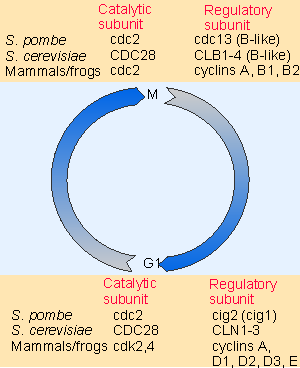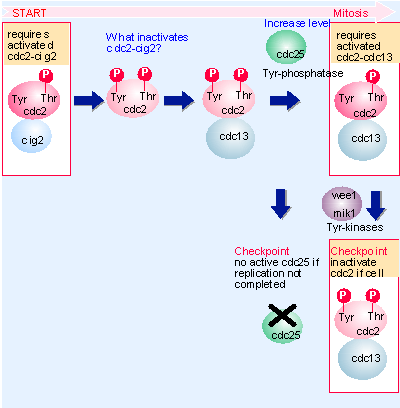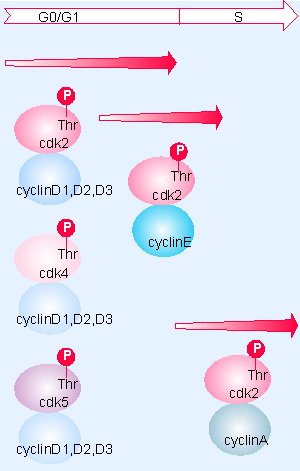8. G0G1 and G1S transitions involve cdk inhibitors
27.7 The animal cell cycle is controlled by many cdk-cyclin complexes |
The conservation of the structure of the M phase kinase between animal cells and yeasts, and the involvement of related dimers that regulate START in both S. pombe and S. cerevisiae, suggest that a similar scheme controls the cycle in animal cells. The major difference is that animal cells have more variation in the subunits of the kinases. Instead of using the same catalytic subunit at both START and G2/M, animal cells use different catalytic subunits at each stage. They also have a large number of cyclins (for review see Norbury and Nurse, 1992).
 |
Figure 27.20 Similar or overlapping components are used to construct M phase kinase and a G1 counterpart. |
The components of the regulatory kinases for both G1/S and G2/M in yeasts and animal cells are summarized in Figure 27.20. The unifying theme is that the kinase consists of a catalytic subunit and a regulatory (cyclin) partner, but there are several types of variation.
At mitosis in animal cells, the Cdc2 catalytic subunit is provided by a single gene. The regulatory partner at mitosis usually is not unique, but is provided by a family of B-type cyclins, and also A-type cyclins in animal cells.
During G1, animal cells have multiple kinases involved in cell cycle control, and they vary in both the catalytic subunit and the regulatory (cyclin) subunit. This contrasts with the retention of a common catalytic subunit in yeasts.
Just as families of cyclins can be defined by ability to interact with cdc2, so may families of catalytic subunits be defined by the ability to interact with cyclins. Catalytic subunits that associate with cyclins are called cyclin-dependent kinases (cdks). Higher eukaryotes possess a large number of genes (~10) related to the true cdc2 homologue. It is not entirely clear how many of these gene products are involved with the cell cycle and how many code for kinases with other functions. The cdk/cyclin dimers have the same general type of kinase activity as the Cdc2-cyclin dimers, and are often assayed in the same way, by H1 histone kinase activity. The involvement of the Cdc2/cdk kinase engines (and/or others related to them) at two regulatory points in vivo is consistent with an increase in H1 kinase activity at S phase as well as at M phase.
The pairwise associations between the catalytic and regulatory subunits are not exclusive, and a particular cyclin may associate with several potential catalytic subunits, while a catalytic subunit may associate with several potential cyclins. The trick is to determine which of these pairwise combinations form in the cell and are concerned with regulating the cell cycle.
Two of the cdk genes, cdk2 and cdk4, code for proteins that form pairwise combinations with potential G1 cyclins. The first and best characterized is cdk2; it has 66% similarity to the cdc2 homologue in the same organism.
G1 cyclins were originally identified as genes that could overcome the deficiency of CLN mutants in S. cerevisiae. Several new types of cyclins (including D and E) were identified by this means. They are distantly related to one another and to other cyclins. Cyclins E accumulates in a periodic manner through the cycle, but is not regulated by periodic destruction of protein. There are 3 D-type cyclins; they form dimers with cdk4 and cdk6.
Proteins described as "cyclins" are therefore now significantly more diverse than the A and B classes encompassed by the original definition. For working purposes, we class as cyclins various proteins that have some sequence relationship to the original class, and which can participate in formation of a kinase by pairing with a Cdc2 or cdk2 or related catalytic subunit. It is not yet certain that all of the proteins presently classed as cyclins in this way in fact have this function in vivo.
The timing of activity of the various forms of cdk- and Cdc2-cyclins during the animal cell cycle suggests a model in which cdk2-G1 cyclin dimers function to regulate progression through G1 and S phase, while Cdc2-cyclinA,B dimers regulate passage through mitosis. We know most about the details of controlling the G2/M transition, but the principles are likely to be similar for G1/S, since the Cdc2 and cdk catalytic subunits conserve the residues that are involved in regulation (for review see Nurse, 1994; Sherr, 1994).
 |
Figure 27.21 Control of mitosis in animal cells requires phosphorylations and dephosphorylations of M phase kinase by enzymes that themselves are under similar control or respond to M phase kinase. |
 |
Figure 27.13 Cell cycle control in S. pombe involves successive phosphorylations and dephosphorylations of cdc2. Checkpoints operate by influencing the state of the Tyr and Thr residues. |
 |
Figure 27.7 The activity of M phase kinase is regulated by phosphorylation, dephosphorylation, and protein proteolysis. The 3 phosphorylated amino acids are: Thr-14, Tyr-15, Thr-161. The first two are in the ATP-binding site. |
Figure 27.21 shows that the components and events in an animal cell mitosis are similar to those in yeast cells (compare with Figure 27.13). The lower part of the figure shows the changes in M phase kinase; the upper part shows the enzymes that catalyze these changes. A cell leaves mitosis with Cdc2 monomers and no mitotic cyclins (because cyclins A and B were degraded during mitosis). Cyclins are then resynthesized. After a lag period, their level reaches a threshold at which they form dimers with Cdc2. But this does not activate the kinase activity; as we saw previously in Figure 27.7, the activity of the dimer is controlled by the state of certain Tyr and Thr residues:
- The phosphate that is necessary at Thr-161 is added by CAK (the Cdc2-activating kinase). CAK activity is probably constitutive (Fisher and Morgan, 1994; Jeffrey et al., 1995).
- The wee1 kinase is a counterpart to the enzyme of S. pombe and phosphorylates Tyr-15 to maintain the M phase kinase in inactive form.
- The Cdc25 phosphatase is a counterpart to the yeast enzyme and removes the phosphate from Tyr-15. Cdc25 is itself activated by phosphorylation; and M phase kinase can perform this phosphorylation, creating a positive feedback loop. Removal of the phosphate from Tyr-15 is the event that triggers the start of mitosis. Cdc25 is itself regulated by several pathways, including phosphatases that inactivate it, but these pathways are not yet well defined.
- Separate kinases and phosphatases that act on Thr-14 have not been identified; in some cases, the same enzyme may act on Thr-14 and Tyr-15.
This means of control is common, but not universal, since in some cells tyrosine phosphorylation does not seem to be critical, and in these cases other means must therefore be used to control the activity of M phase kinase.
 |
Figure 27.22 Several cdk-cyclin complexes are active during G1 and S phase. The shaded arrows show the duration of activity. |
Different cdk-cyclin dimers may regulate entry into S and progression through S in animal cells. Some may be concerned with entering the cycle from G0 or exiting to it. The pairwise combinations of dimers that form during G1 and S are summarized in Figure 27.22. All of these dimers require phosphorylation on Thr-161 by CAK to generate the active form (Blow and Nurse, 1990; for review see Reed, 1992; Herr, 1993).
The synthesis of D cyclins is activated when growth factors stimulate cells to reenter the cycle from G0. The D cyclins have short half-lives, and their levels decline rapidly when the growth stimulus is removed. They may be involved with triggering reentry of quiescent cells into the cycle. Loss of D cyclins could be a trigger for a cell to leave the cell cycle for the G0 state.
The activity of D cyclins is required during the latter part of G1, but not close to the G1/S boundary. Their functions may be partly redundant, but there are some differences between the D cyclins in their susceptibilities to inhibitors of the cell cycle. The significance of the ability of each D cyclin to associate with 3 different cdk subunits is not clear.
Activity of the cdk2-cyclin E complex is necessary to enter S phase. Cyclin E is synthesized during a period that spans the G1/S transition, but we do not yet know how and when it is inactivated or at what point it becomes dispensable. Cyclin E clearly has a unique role.
Progression through S phase requires the cdk2-cyclin A complex. Cyclin A is also required to associate with cdc2 for entry into mitosis. The dual use of cyclin A in animal cells appears to be the only case in which a cyclin is used for both G1/S and G2/M transitions.
 |
Figure 13.34 Licensing factor in the nucleus is inactivated after replication. A new supply of licensing factor can enter only when the nuclear membrane breaks down at mitosis. |
The states of cyclin-cdk complexes may influence the licensing system that prevents reinitiation of replication (see Figure 13.34). Cyclin B-cdk complexes prevent Cdc6 from loading on to the origin; an orderly succession of events is thus determined, since the degradation of cyclin B in mitosis releases the block and allows the procedure to start for forming a prereplication complex at the origin.
Both the beginning and end of S phase are important points in the cell cycle. Just as a cell must know when it is ready to initiate replication, so it must have some means of recognizing the successful completion of replication. This may be accomplished by examining the state of DNA.
Inhibitors of DNA replication can block the cell cycle. The effect may depend on the presence of replication complexes on DNA. We do not know how they block the activation of M phase kinase.
Another interesting connection between DNA and the cell cycle has been revealed by the properties of the RAD9 mutant of S. cerevisiae. Wild-type yeast cells cannot progress from G2 into M if they have damaged DNA. This can be caused by X-irradiation or by the result of replication in a mutant such as cdc9 (DNA ligase). Mutation of RAD9 allows these cells to divide in spite of the damage. RAD9 therefore exercises a checkpoint that inhibits mitosis in response to the presence of damaged DNA. The reaction may be triggered by the existence of double-strand breaks. RAD9-dependent arrest and recovery from arrest can occur in the presence of cycloheximide, suggesting that the RAD9 pathway functions at the post-translational level. At least 6 other genes are involved in this pathway; its ultimate regulatory target remains to be found (Weinert and Hartwell, 1988).
Other controls that ensure an orderly progression through the cell cycle and that can be visualized in the context of checkpoints include monitoring the completion of DNA replication and checking cell size. It may be necessary to bypass some of these checkpoints in early embryogenesis; for example, early divisions in Drosophila in effect are nuclear only (because there are no cellular compartments: see 29 Gradients, cascades, and signaling pathways). It may be significant that the product of string (the counterpart of S. pombe cdc25 which exercises a size-dependent control) is present at high levels in these early cycles. After the 14th cycle, division becomes dependent on string expression. It is at this point that cellular compartments develop, and it becomes appropriate for there to be a checkpoint for cell size. string may provide this checkpoint.
| Reviews | |
| Herr, C. J. (1993). Mammalian G1 cyclins. Cell 73, 1059-1065. | |
| Norbury, C. and Nurse, P. (1992). Animal cell cycles and their control. Ann. Rev. Biochem 61, 441-470. | |
| Nurse, P. (1994). Ordering S phase and M phase in the cell cycle. Cell 79, 547-550. | |
| Reed, S. I. (1992). The role of p34 kinases in the G1 to S phase transition. Ann. Rev. Cell Biol. 8, 529-561. | |
| Sherr, C. J. (1994). G2 phase progression: cycling on cue. Cell 79, 551-555. | |
| Research | |
| Blow, J. J. and Nurse, P. (1990). A cdc2-like protein is involved in the initiation of DNA replication in Xenopus egg extracts. Cell 62, 855-862. | |
| Fisher, R. P. and Morgan, D. O. (1994). A novel cyclin associates with MO15/cdk7 to form the cdk-activating kinase. Cell 78, 713-724. | |
| Jeffrey, P. D. et al. (1995). Mechanism of cdk activation revealed by the structure of a cyclin A-cdk2 complex. Nature 376, 313-320. | |
| Weinert, T. A. and Hartwell, L. H. (1988). The RAD9 gene controls the cell cycle response to DNA damage in SaccharomyceS. cerevisiae. Science 241, 317-322. | |